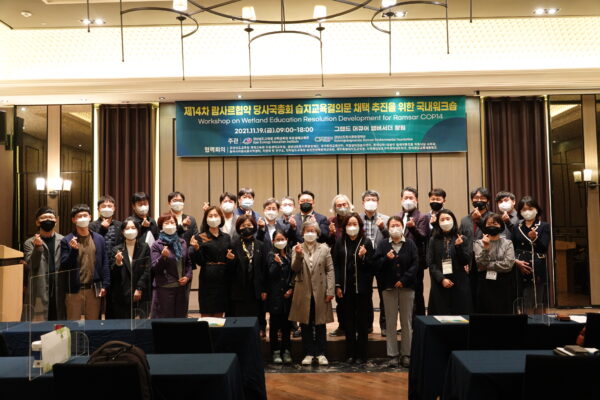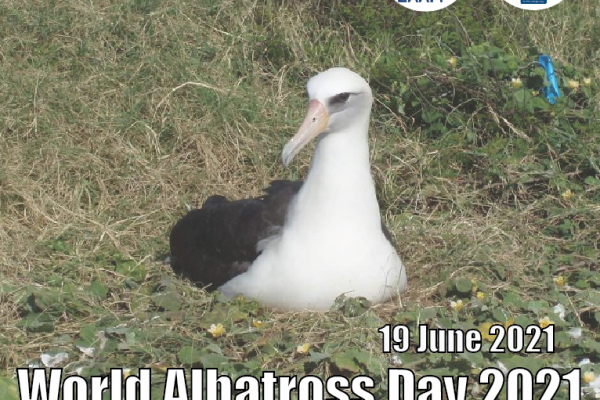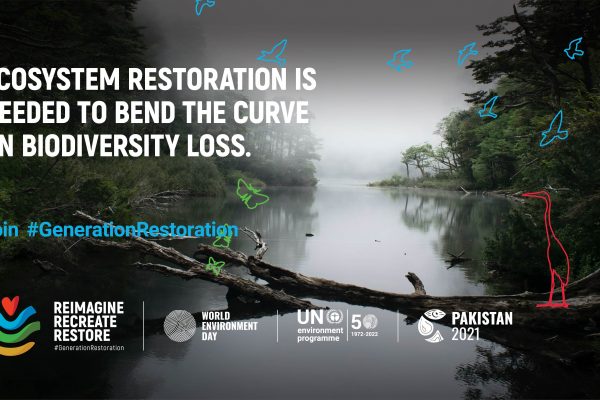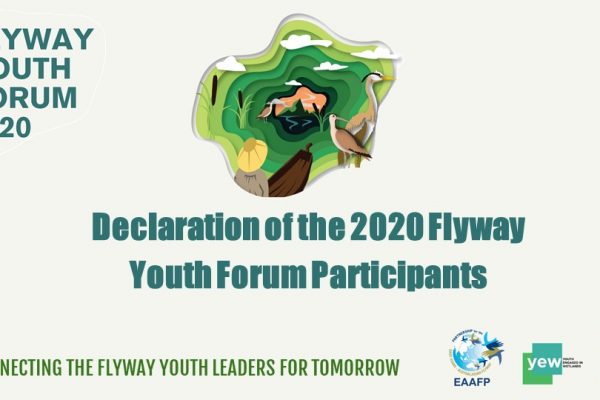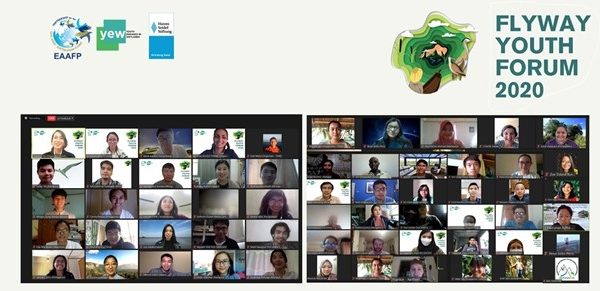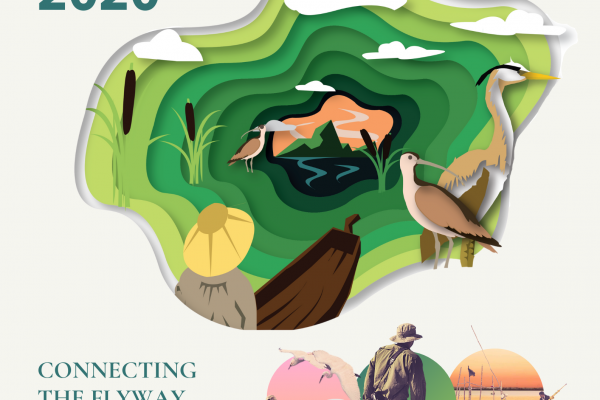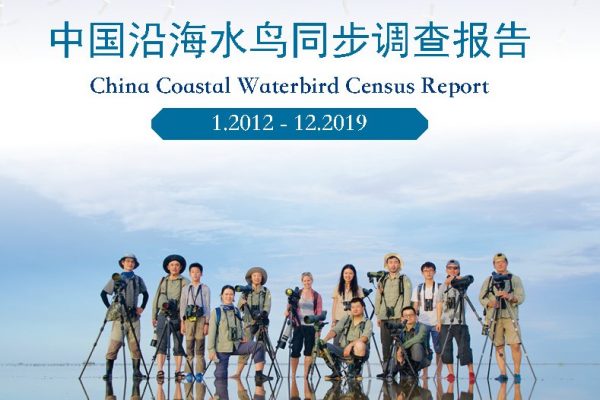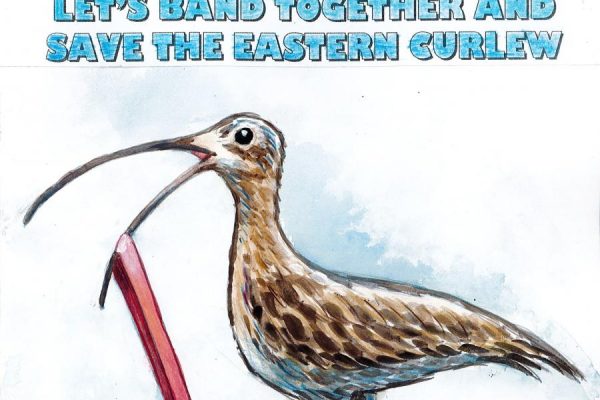-
Second Training Workshop of Youth Think Tank Competition for EAA Flyway is about Local Community Engagement
2nd training Workshop of Youth Think Tank Competition for EAA Flyway - Understanding Nature-based Solutions and local community engagement in conservation of migratory waterbirds and wetlands During the 1st EAA Flyway Think Tank Competition Workshop last year, we gained insight into the high level of interest that youth participants had in environmental issues, especially wetlands and migratory waterbirds. Many participants showed their eagerness to learn more about conservation and how they can engage in the implementation of local actions to decision-making. To better equip young people, especially future young professionals to take part in the conservation of migratory waterbirds, their habitats, and local communities relying on the wetlands, the EAAFP Secretariat is pleased to organize a 2nd training workshop with a focus on local community engagement. Objectives: To introduce the concept of Nature-based Solutions as a tool that links local community engagement and conservation To enhance knowledge and skills on local community engagement for conservation projects Date: 28th – 29th May, 2022 (Saturday and Sunday) Part 1. Open webinar “Understanding Nature-based Solutions and local community engagement in conservation of migratory waterbirds and wetlands” Date and time:28th May, 2022, 1500-1600 KST (1 hour) Registration: https://us02web.zoom.us/meeting/register/tZUkfuipqDIrHdF_cnd72-FUQOP4ZMRFt8KZ Livestream on EAAFP Facebook: https://www.facebook.com/eaafp Part 2. In-depth workshop “Engaging Local Community in conservation of migratory waterbirds and wetlands” Date and time:28th & 29th May, 2022, 1700-1900 KST (2 hours/day) Quota: 30 people Registration: : https://docs.google.com/forms/d/e/1FAIpQLSebISr3L5X2u0cbNI5Q0LOPzvWX4AcOlwxx00P1BV9a6-_lgw/viewform Deadline of registration: 13th May, 2022 Tool: Zoom Target Audience: Young conservationists, green youth groups., local and international NGOs young staffs, university students Eligibility for In-depth workshop: Aged 18-29(under 30 on the date of application) Applicants with a nationality from EAA Flyway countries will be given priority to join Applicants to the EAAFP Youth Think Tank Competition will be given priority to join Important notice We are using Zoom for the webinars and workshop. Please download the Zoom App (https://zoom.us/download) prior to the workshop. Successful applicants to the In-depth workshop will receive a separate email for the Zoom link and workshop rundown. It is a series of four workshops, only those who attend at least two In-depth workshops of the Youth Think Tank Competition Programme will receive a certificate of participation. Programme Part 1 Webinar – "Understanding Nature-based Solutions and local community engagement in conservation to migratory waterbirds and wetlands" Keynote speakers Ms. Kathryn Bimson Programme Officer, Water, Wetlands and Nature-based Solutions for Climate at the IUCN Asia Regional Office. Ms. Kathryn Bimson has been working on wetlands in Southeast Asia for the last nine years, and is currently coordinating the regional implementation of a number of projects related to Nature-based Solutions and wetlands in the Lower Mekong Basin. Ms. Bimson also supports the Secretariat for the Indo-Burma Ramsar Regional Initiative, working closely with the governments of Cambodia, Lao PDR, Myanmar, Thailand and Viet Nam to strengthen the implementation of the Ramsar Convention in the region. Ms. Bimson holds an MSc. in Biology from the Prince of Songkla University, Thailand, and a BSc. in Biology from Fairfield University, USA. She previously received a National Geographic Young Explorer’s Grant to study private sector engagement in coral reef restoration, and spent her first year in Thailand as an English Teaching Assistant with the US Fulbright Program. Mr. Jiefeng Jin Yangtze Basin Program Manager, China Programme, International Crane Foundation (ICF) Mr. Jiefeng Jin started his conservation career in 2009 and joined ICF in 2014. To conserve the Critically Endangered species Siberian Crane and other three crane species as well as their wetland habitats, he maintains and develops good relationships with various partners, donors and other stakeholders, designs and implements ICF conservation strategies in wintering area of Yangtze River Basin, particularly in Poyang Lake where over 98% of the world population of Siberian Crane together with almost all of the western population of White-naped Crane are wintering. He works closely with national and international research institutes to advise on management actions for protecting cranes and other waterbirds. He is committed to promoting public awareness and engagement, such as recruiting and training volunteers from local communities and colleges to carry out education and outreach for the public. He has a deep interest in working with local communities to safeguard their resource base while restoring landscapes important to cranes. He obtained his second M.S. degree in Environmental Conservation at the University of Wisconsin-Madison in 2020. Part 2 In-depth workshop “Engaging Local Community in conservation of migratory waterbirds and wetlands” Key Trainer Ms. Mercy Kariuki Programme Officer, BirdLife International Ms. Mercy Kariuki is a Kenyan conservationist with an interest in community conservation work especially in Africa and is a recent graduate of MPhil in Conservation Leadership from the University of Cambridge. She has worked for BirdLife International (both in Nairobi & currently in Cambridge office) for about 10 years in various capacities & positions. Through the BirdLife Local Engagement and Empowerment Programme, Mercy has worked with BirdLife Partners supporting community-led conservation initiatives, developing community conservation projects/proposals, managing projects, meeting local communities to conduct capacity assessments among other activities that involve community engagement. Mercy enjoys outdoor activities such as birdwatching, hiking and mountain climbing. Case Study Speakers for In-depth Workshop Mr. George Ndung’u Muigai Founder, Cranes Conservation Volunteers Prof. Wataru Kitamura Associate Professor, Department of Restoration Ecology and Built Environment, Faculty of Environmental Studies, Tokyo City University Ms. Amy Lecciones Executive Director, Society for the Conservation of Philippine Wetlands, Inc. Mr. Johnson Chung Project Manager, Hong Kong Bird Watching Society Supporting organizations: Topics of upcoming workshops: 3rd workshop: Project management, evaluation and impact assessment, and fund-raising (6-7, August, 2022) 4th workshop: Communication (story-telling and scientific communication) and project evaluation, impact measurement (September, 2022) More information about the Youth Think Tank Competition for the EAA:https://www.eaaflyway.net/thinktankcompetition/ Playback of the workshop: https://www.eaaflyway.net/2022/06/10/eaaf-youth-think-tank-2nd-workshop/
Continue reading -
Development Workshop in Ro Korea on the proposed Wetland Education Ramsar Resolution
On 19th November, 2021, the “Wetland Education Resolution Development for Ramsar COP14 Workshop” was held in Gyeonsangnamdo…
Continue reading -
World Albatross Day 2021 “Ensuring Albatross-friendly Fisheries”
Today is the World Albatross Day (WAD)! It was launched in 2020 by the Agreement on the Conservation of Albatrosses and Petrels (ACAP) to dedicate 19th June every year to raise awareness of the conservation needs of albatrosses, petrels, and shearwaters. Many of them are being killed as a result of fisheries operations and other human-induced threats. This year, the theme for WAD2021 is “Ensuring Albatross-Friendly Fisheries”, to highlight the problems of populations of albatrosses, and other seabirds that are declining due to fisheries bycatch. Words from Mr. Robert (Robb) Kaler, Chair of EAAFP and Chair of EAAFP Seabird Working Group “This year’s theme of World Albatross Day “Ensuring Albatross-Friendly Fisheries” reminds us of the impact that human brought to, not only Albatrosses but many seabird species. Fishery bycatch is one of the main threats to the decline of seabirds worldwide. Scientists, government agencies, and the fishing industry sector are now implementing mitigation, in which some of them are simple to apply. In the EAA Flyway, studies about seabirds are very limited. World Albatross Day is a great opportunity to raise the awareness on seabird conservation, and highlight the importance of reducing impacts of the world’s fisheries on seabirds and other non-targeted species.” The problems of fisheries threatening albatrosses and other seabirds Many seabird species, especially Albatrosses, spend most of their lives soaring in open seas, except during the breeding time when they return to land to nest. Yet staying far from land does not stop seabirds from being impacted by human activities. In fact, nearly half of the world's seabird populations are declining, especially Albatrosses, with 15 of 22 species are threatened with extinction. Albatrosses feed mainly on fish and squid on the ocean’s surface. They can smell their prey from a far (up to 20 km away!). This extraordinary ability, however, exposes them to danger, for they are attracted to fishing vessels which use baited hooks in the longline fishery and can get caught and drown. An estimated 160,000 to 320,000 seabirds are killed annually in longline fisheries1. Trawl, purse seine, and gillnet fisheries are other gear types also have seabird bycatch issues. At least 400,000 seabirds (especially diving species) are estimated to be killed annually in gillnet fisheires globally2. According to a global assessment of threats to seabirds, the three primary threats are: (i) invasive species impacting 165 species, (ii) bycatch in fisheries affecting 100 species, and (iii) climate change affecting 96 species3. Albatrosses and petrels killed by bycatch in fishery ©Fabiano Peppes Conservation work in the EAA Flyway Scientists around the world are working on solutions to reduce seabird bycatch. Some of these methods are: bird-scaring lines (also called tori lines) with colorful streamers attached to lines to keep birds away, fishing at night to reduce interactions between birds and fishing activities, and adding weights to increase the sinking speed of baited hooks. Source: Birdlife International (2021) Towards Seabird-safe Fisheries - Global Efforts & Solutions In the East Asian-Australasian Flyway, especially in the Asian region, research on seabirds is rather limited, let alone the study on the impact of fisheries on seabirds. Yet, there is work by BirdLife International and Wild Bird Society of Japan (both EAAFP Partners), which developed a nationwide-scale hotspot map of seabird bycatch in gillnet fisheries in Japan (read [more]). Another project to evaluate mitigation ideas of seabird bycatch in gillnet under a controlled condition is ongoing, and data collection of seabird bycatch in gillnet fisheries in collaboration with local fishers is about to begin. Know about the three species of Albatrosses in EAAFlyway Laysan Albatross ©Simba Chan Laysan Albatross, Phoebastria immutabilis, is a large seabird (length: 79-81 cm) with white head with dark gray-brown upper wings. It is the most common albatross in open Pacific Ocean. The species is listed as Near Threatened (NT) by IUCN. Main threats in breeding sites are the invasion of rats and feral cats. Conservation or eradication of Polynesian rats had been successfully managed. The famous oldest known wild bird in the world Wisdom, still raising a chick at age 70, is of this species. Black-footed Albatross at Ogasawara Island ©Tomohiro Deguchi Black-footed Albatross, Phoebastria nigripes, (length: 68-74cm) has long, narrow wings and mostly dark except for a white ring around its long, thick bill. It breeds on oceanic islands across the tropical and subtropical North Pacific Ocean and adults concentrate on nesting islands in Izu and Ogasawara Islands of Japan and on Senkaku Islands. The species is listed as Near Threatened (NT) by IUCN because it is taken incidentally by longline fishery. Main threats used to be feral cats on Northwestern Hawaiian Islands where the eradication has been taken effectively. Short-tailed Albatross ©Lee Kwok Shing Short-tailed Albatross, Phoebastira albatrus is a large pelagic bird (length:84-94 cm) with long narrow wings adapted for soaring just above the water surface. It spends most of its life over northern Pacific Ocean and breeds on islands off Japan and more recently, Midway Atoll. Its population is estimated to be 7,365 birds and listed as Vulnerable (VU) by IUCN. Erosion, flooding, and high winds (blow chicks off their nests) at Tsubame-zaki colony, and black rats on Torishima remain as threats to the bird despite habitat management efforts that have been undertaken. Join the World Albatross Day activities: Follow the Albatross Task Force on Instagram (https://www.instagram.com/albatross_stories/), join the Albatross World Cup, take the Friday Quiz, see how much you know about Albatrosses in the world. Check also their Facebook (https://www.facebook.com/Albytaskforce/) and Twitter (https://twitter.com/AlbyTaskForce) World Albatross Day events in Japan (in Japanese): 世界アルバトロスデー Join the quiz from EAAFP about the World Albatross Day, click [here]! https://www.eaaflyway.net/wp-content/uploads/2021/06/WAD-video_final.mp4 References: Anderson, al. 2011. Global seabird bycatch in longline fisheries. Endang. Species Res. 14, 91–106 (http://www.int-res.com/abstracts/esr/v14/n2/p91-106/) Žydelis, al. 2013. The incidental catch of seabirds in gillnet fisheries: A global review. Biological Conservation. 162: 76-88. (https://doi.org/10.1016/j.biocon.2013.04.002) Dias al. 2019. Threats to seabirds: A global assessment. Biological Conservation. 237: 525-537 (https://doi.org/10.1016/j.biocon.2019.06.033) Birdlife International (2021) Towards Seabird-safe Fisheries - Global Efforts & Solutions.
Continue reading -
World Environment Day 2021 call for actions to restore our degraded ecosystems
World Environment Day is celebrated on 5th June every year since 1974. Convened by UN Environment Programme, it is one of the most renowned events to engage governments, businesses and citizens for environmental actions to address worldwide environmental issues, such as climate change, biodiversity loss. In 2021, the theme is “Ecosystem restoration”. Habitat loss and degradation are depleting natural resources and their associated ecosystem services. Over the last century, more than half of the wetlands in the world have been destroyed. For wetlands in the East Asian–Australasian Flyway, they are not only supporting millions of migratory waterbirds which breed, rest, and feed in their annual journey, but also provide food and natural resources to other wildlife and people, protecting the shorelines, reducing disaster risks, purifying water, and carbon sequestration. In a recent study, the monetary value of both inland and coastal wetlands is more than 2 times the value for all forests1. Despite the huge values wetlands provide, they are the most vulnerable ecosystems in the world. “The value of the ecosystem services of wetlands and its importance to humans and biodiversity need to be recognized by decision-makers, government officers and the general public. We have to work together between sectors, disciplines and countries, and act quickly! We have lost too many of our wetlands and need to now work on their restoration. On the World Environment Day, I echo the call from the United Nations for the Partners of EAAFP to take action to restore our lost natural habitats and conserve the existing ones” said Mr. Doug Watkins, Chief Executive of EAAFP Secretariat. On 4th June 2021, 1600 EAT, the United Nations is holding a Virtual Launch Gala of the UN Decade on Ecosystem Restoration. Watch the virtual event of the launch here: EAAFP Secretariat also set up an interactive quiz game about the ecosystems around us. Join the quest [here] or click the image. For more information about World Environment Day 2021, visit [here]. Reference [1]: Davidson NC, van Dam AA, Finlayson CM, McInnes RJ (2019a) The worth of wetlands: revised global monetary values of coastal and inland wetland ecosystem services. Marine and Freshwater Research. https://doi.org/10.1071/MF18391
Continue reading -
Promoting the wise use of artificial wetland – fishponds in Hong Kong
Conserving the natural habitats is the priority for conservation in the field, but at sites where habitats had been modified and degraded, we should promote the restoration and wise…
Continue reading -
Declaration of the 2020 Flyway Youth Forum
Preamble Wetlands are one of the most productive ecosystems on the planet, home to a great diversity of migratory waterbirds and providing countless ecosystem services to people and…
Continue reading -
Youth declared for global stand to conservation of wetland and migratory waterbirds during the Flyway Youth Forum
The first-ever virtual Flyway Youth Forum, organized by The East Asian-Australasian Flyway Partnership (EAAFP) and
Continue reading -
Connecting the Flyway Youth Leaders for Tomorrow
The first Flyway Youth Forum Pre-event press release The first-ever Flyway Youth Forum, organized…
Continue reading -
China Coastal Waterbird Census Report 2012-2019 has been published!
Sponsored by the Swire Charitable Trust, the latest China Coastal Waterbird Census Report had been published in September 2020 by the Hong…
Continue reading -
Competition for primary students raises awareness of shorebirds in Australia
Hundreds of primary children across Australia recently participated in the third annual Shorebirds Competition run by Australian Government research organisation, ANSTO. Offered nationally for the first time this year,…
Continue reading

